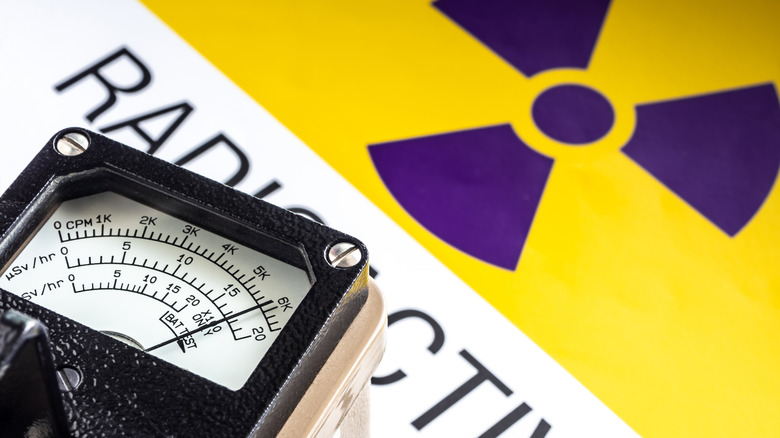Which Of Your Home Electronics Gives Off The Most Radiation?
Every electronic device in your home emits some form of radiation. But it's important to understand exactly what that means. When you hear "radiation," you might picture X-rays, radioactive materials, or nuclear accidents. In reality, though, most household electronics produce what are known as electromagnetic fields (EMF) or electromagnetic radiation. This type of radiation is measured in milligauss or microteslas, not in roentgen, which is used for the ionizing radiation we typically fear.
EMF refers to the electric and magnetic fields generated by the flow of electricity (in wires, circuits, or motors) and by wireless transmission (Wi-Fi or mobile devices). These kinds of fields are non-ionizing, which means they don't have enough energy to knock electrons out of atoms, or directly damage DNA the way X-rays or gamma rays do. That means that the nature of "radiation" here is less dramatic.
Not all sources of electromagnetic fields are made equal, though, and different devices produce different levels of EMF. For example, devices that handle heavy currents or high voltages, have larger motors or heating elements, or generate wireless radio frequencies tend to yield higher levels than simple gadgets. Several research summaries note that the magnitude of exposure decreases rapidly with distance and depends heavily on usage patterns. In the home electronics context, we're thus not dealing with especially concerning danger levels in most cases. But because nearly all devices emit EMFs to some degree, the question arises: Which of them give off more radiation and what, if anything, does that mean for our health?
Radiation levels of common household items
Among kitchen appliances, microwave ovens can register relatively high magnetic field readings if measured very close to the unit, approximately 100 milliGauss (mG) — or about 10 microtesla — at around one arm's length from the unit. Maximum magnetic field levels of around 70 microtesla (µT) were found at the surface of some microwaves. If you stand close during use, your exposure goes up, but the field drops quickly just a short distance away.
A vacuum cleaner, especially older, powerful models, can produce sizable magnetic fields when in use. For example, some vacuums operate in the range of 0.7 to 2.3 µT at a distance of 30 cm from the surface. Although robotic vacuum cleaners emit less EMF (due to smaller motor size), it's not zero.
A common appliance that draws a substantial current is the electric kettle. These electronics can exhibit up to around 15 µT maximum at the surface. While the exposure falls off rapidly with distance, if you lean over or stand close while it's on, you'll get higher exposure than many lighter-duty devices.
Historically, TVs (especially older CRT models) had higher EMFs; Modern, flat-screen TVs are much lower. Typical TVs in modern homes show up to 0.5 µT maximum at a normal viewing distance. While this EMF reading is still above zero, it puts modern TVs low on our list of household items that give off radiation.
Wireless devices such as Wi-Fi routers and smartphones emit radiofrequency (RF) electromagnetic energy rather than high-current low-frequency magnetic fields, so their relative emissions are comparatively low. Moreover, according to the American Cancer Society and the National Cancer Institute, most RF radiation from wireless devices has not been shown to cause cancer in humans. Thus, wireless gadget emissions come in last in terms of household "radiation" exposure from typical wiring or appliance current.
Should we be worried about household electronic EMFs?
When we talk about "radiation" from home appliances, it's important to remember we're dealing with non-ionizing electromagnetic fields. This is not a type of radiation that can cause direct damage to our DNA. Most appliances generate extremely low-frequency (ELF) fields from electric current, while wireless devices emit radiofrequency (RF) signals. These forms of radiation operate at energy levels far below what's needed to break chemical bonds in the body.
Research into the health effects of everyday EMF exposure has been ongoing for decades. The International Agency for Research on Cancer classifies ELF magnetic fields as "possibly carcinogenic," but this classification reflects limited evidence from some studies of childhood leukemia. There's no confirmed causal link. Large studies in adults have not demonstrated a consistent connection between typical home EMF exposure and cancers such as brain tumors or breast cancer. Similarly, despite claims that cell phones are carcinogenic, major reviews of RF exposure from cell phones and Wi-Fi have not shown clear evidence of increased cancer risk in the general population.
One key factor is distance. EMF strength decreases rapidly with distance. Even moving back by one foot can significantly reduce exposure. This is why heavy appliances like microwaves or vacuums are generally safe when they're running. So, should you worry? The consensus from health agencies is that normal household EMF exposure is unlikely to pose harm for most people. Still, practical, low-effort precautions make sense. Avoid leaning against running appliances, don't sleep with the Wi-Fi router under your pillow, and take a small step back while the microwave is operating. Awareness matters, but being alarmed is not necessary.


